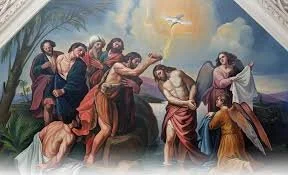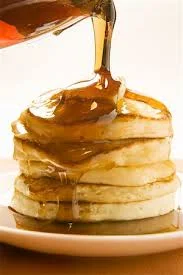Each layer of reality is a substrate for a story. Different stories unfold on the different layers of reality. Each story, however, can be told in a variety of ways. In other words, a single story is not limited to a single description. Multiple descriptions may be talking about the same story. A story is embedded in its substrate of reality, locked into a fixed position in space and time. A description of a story, however, is not subject to the same constraints. A description can take place before, during or after the unfolding of a story.
Descriptions of a story can be stacked one on top of the other. Stacking multiple description together often gives us a clearer insight into a story than viewing a story via only one description.
Let me give you an example.
The baptism of Jesus can be viewed as a baptism in water (Matthew 3:13-17) or a baptism in violence (Matthew 20:21-23). If both are descriptions of the same story, we should be able to stack them together. They should fit together nicely not awkwardly.
By stacking them together, we see that Jesus’s baptism in water is a “pre-enacting” of the Crucifixion and the Resurrection. The Mass is a “re-enacting” of the Crucifixion and the Resurrection. The baptism of Jesus is a “pre-enacting”.
Immersion in the River Jordan corresponds to the Crucifixion. Immersion is done by a reluctant John (Matthew 3:14). John knew that there was something wrong with humanity baptizing divinity but Jesus persuaded John to baptize him in order “to fulfill all righteousness” (Matthew 3:15).
Emergence from the River Jordan corresponds to Resurrection. After Jesus completed his mission God descended upon him (Matthew 3: 16) and the Father praised his dearly beloved Son, well-pleased at his success (Matthew 3:17).
As you can see, we stacked the description of Jesus’s baptism over the story of the Crucifixion and Resurrection. It fits perfectly. In doing the stacking, we see the story of the Crucifixion and Resurrection in a clearer light.
The story that unfolded on the road from the Crucifixion to the Resurrection is the greatest story ever told. Like Jesus, we, too, are baptized. Our baptism is an invitation to reflect on the baptism of Jesus, the immersion and the emergence, the Crucifixion and the Resurrection. Our baptism reminds us that the byproduct of his baptism was forgiveness. The sweet syrup of forgiveness poured from the reservoir of his most Sacred Heart, through his bloody wounds and into the Valley of Tears. JESUS ANSWERED THE EVIL THAT WE DID TO HIM WITH THE KISS OF FORGIVENESS (Luke 15:20) (Luke 23:34) (Matthew 7:6) (Matthew 5:38-48).
Our baptism deposits us in the middle of Jesus's baptism, in the middle of his immersion and his emergence, in the middle of Crucifixion and Resurrection. Baptism is one of the landmarks that our God fashioned to draw our attention to the story that unfolded on the road from the Crucifixion to the Resurrection. There are other landmarks. For instance, God marked the location of the Jesus's Crucifixion and Resurrection with a very conspicuous landmark. The very conspicuous landmark was the Cross of Christ. Rally 'round the Cross! The Catholic Mass is another landmark of the Crucifixion and Resurrection. Rally 'round the Mass!
Christianity is a treasure map for treasure hunters engaged in a treasure hunt. The Cross, baptism, the Mass mark the spot of the treasure (1 Corinthians 1:17). GRAB YOUR SHOVEL. GO TO THE ROAD FROM THE CRUCIFIXION TO THE RESURRECTION. DIG THE TREASURE UP (Matthew 13:44). MAKE YOURSELF RICH (John 4: 13-14) (John 10:10).
Note: The Mass is a re-enacting of the Crucifixion and Resurrection - the bloodless sacrifice based on the bloody sacrifice.
All Christianity points to the story that unfolded on the road from the Crucifixion to the Resurrection. Perhaps the story is important?
P.S. Can the story of the burning bush be added to the stack? Is Jesus is the bush we burned that was not consumed? Is the area around the burning bush - the holy ground - the road from the Crucifixion to the Resurrection?



